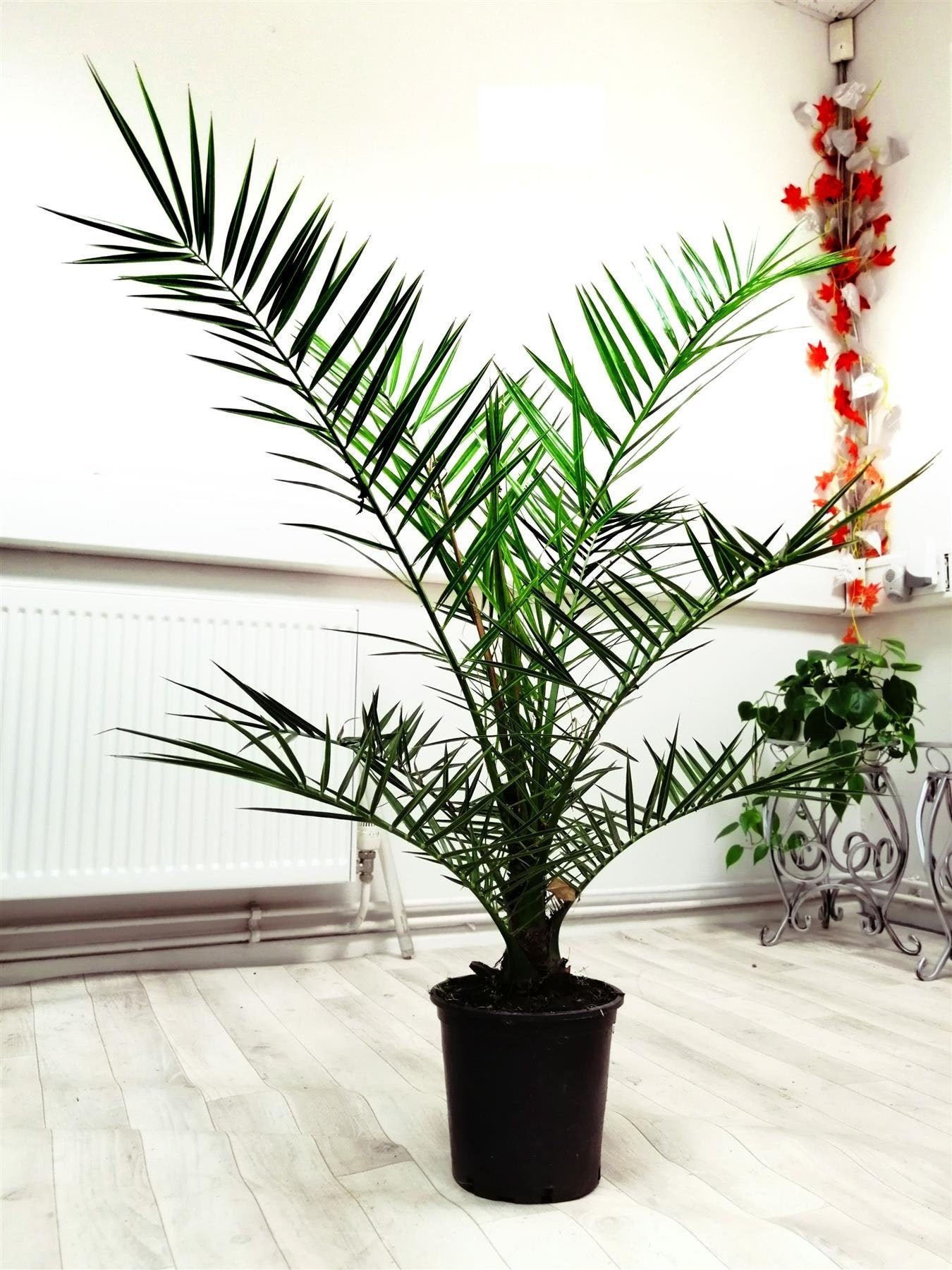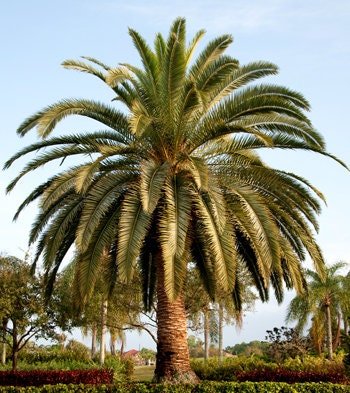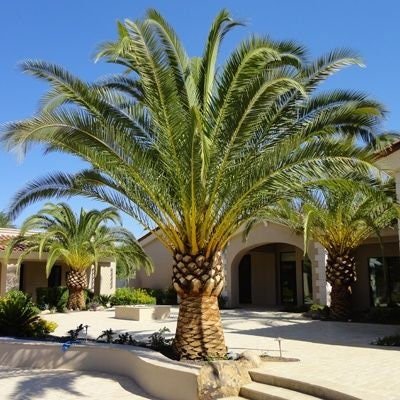 Image 1 of 3
Image 1 of 3

 Image 2 of 3
Image 2 of 3

 Image 3 of 3
Image 3 of 3




Phoenix canariensis 'Canary island palm' seeds
$8.50
You will receive 10 seeds.
Phoenix canariensis is a species of flowering plant in the palm family Arecaceae, native to the Canary Islands
Bag method is a good way to start these plants.
Light: Bright, indirect light to partial shade. Some morning or evening sun would be an advantage. Water: Water when the soil is starting to become slightly dry at the top. Palms don't like sitting in wet soil so do not over-water, however keep moist particularly during the summer.
Palm trees are a popular choice for gardens and landscapes due to their tropical appearance and ability to thrive in warm climates. Here are some general instructions for growing palm trees from seeds:
Choose a planting location that receives full sun and has well-draining soil. Palm trees prefer a soil that is rich in organic matter and slightly acidic, with a pH between 6.5 and 7.5.
Prepare the soil by loosening it with a garden fork and mixing in some compost or well-rotted manure. This will help the soil drain well and provide the nutrients the palm tree seeds need to germinate.
Soak the palm tree seeds in water for 24 hours to soften the seed coat and encourage germination.
Fill a planting container with a well-draining seed starting mix and moisten the soil evenly.
Sow the soaked palm tree seeds on the surface of the soil, spacing them about 1 inch apart. Cover the seeds with a thin layer of soil, about 1/4 inch deep.
Place the planting container in a warm location that receives indirect sunlight. The soil temperature should be kept between 75 and 90 degrees Fahrenheit to encourage germination.
Water the palm tree seeds regularly, providing enough moisture to keep the soil consistently moist but not waterlogged.
Once the palm tree seedlings are large enough to handle, transplant them into individual pots or into the garden. Choose a location that receives full sun and has well-draining soil.
Water the palm tree seedlings regularly, providing enough moisture to keep the soil consistently moist but not waterlogged. Fertilize the seedlings once a month during the growing season with a balanced fertilizer, following the manufacturer's instructions for the appropriate amount to use.
I hope these instructions are helpful! Let me know if you have any questions or need further guidance.
Phoenix canariensis is a species of flowering plant in the palm family Arecaceae, native to the Canary Islands
Bag method is a good way to start these plants.
Light: Bright, indirect light to partial shade. Some morning or evening sun would be an advantage. Water: Water when the soil is starting to become slightly dry at the top. Palms don't like sitting in wet soil so do not over-water, however keep moist particularly during the summer.
Palm trees are a popular choice for gardens and landscapes due to their tropical appearance and ability to thrive in warm climates. Here are some general instructions for growing palm trees from seeds:
Choose a planting location that receives full sun and has well-draining soil. Palm trees prefer a soil that is rich in organic matter and slightly acidic, with a pH between 6.5 and 7.5.
Prepare the soil by loosening it with a garden fork and mixing in some compost or well-rotted manure. This will help the soil drain well and provide the nutrients the palm tree seeds need to germinate.
Soak the palm tree seeds in water for 24 hours to soften the seed coat and encourage germination.
Fill a planting container with a well-draining seed starting mix and moisten the soil evenly.
Sow the soaked palm tree seeds on the surface of the soil, spacing them about 1 inch apart. Cover the seeds with a thin layer of soil, about 1/4 inch deep.
Place the planting container in a warm location that receives indirect sunlight. The soil temperature should be kept between 75 and 90 degrees Fahrenheit to encourage germination.
Water the palm tree seeds regularly, providing enough moisture to keep the soil consistently moist but not waterlogged.
Once the palm tree seedlings are large enough to handle, transplant them into individual pots or into the garden. Choose a location that receives full sun and has well-draining soil.
Water the palm tree seedlings regularly, providing enough moisture to keep the soil consistently moist but not waterlogged. Fertilize the seedlings once a month during the growing season with a balanced fertilizer, following the manufacturer's instructions for the appropriate amount to use.
I hope these instructions are helpful! Let me know if you have any questions or need further guidance.
Quantity:
Add To Cart
You will receive 10 seeds.
Phoenix canariensis is a species of flowering plant in the palm family Arecaceae, native to the Canary Islands
Bag method is a good way to start these plants.
Light: Bright, indirect light to partial shade. Some morning or evening sun would be an advantage. Water: Water when the soil is starting to become slightly dry at the top. Palms don't like sitting in wet soil so do not over-water, however keep moist particularly during the summer.
Palm trees are a popular choice for gardens and landscapes due to their tropical appearance and ability to thrive in warm climates. Here are some general instructions for growing palm trees from seeds:
Choose a planting location that receives full sun and has well-draining soil. Palm trees prefer a soil that is rich in organic matter and slightly acidic, with a pH between 6.5 and 7.5.
Prepare the soil by loosening it with a garden fork and mixing in some compost or well-rotted manure. This will help the soil drain well and provide the nutrients the palm tree seeds need to germinate.
Soak the palm tree seeds in water for 24 hours to soften the seed coat and encourage germination.
Fill a planting container with a well-draining seed starting mix and moisten the soil evenly.
Sow the soaked palm tree seeds on the surface of the soil, spacing them about 1 inch apart. Cover the seeds with a thin layer of soil, about 1/4 inch deep.
Place the planting container in a warm location that receives indirect sunlight. The soil temperature should be kept between 75 and 90 degrees Fahrenheit to encourage germination.
Water the palm tree seeds regularly, providing enough moisture to keep the soil consistently moist but not waterlogged.
Once the palm tree seedlings are large enough to handle, transplant them into individual pots or into the garden. Choose a location that receives full sun and has well-draining soil.
Water the palm tree seedlings regularly, providing enough moisture to keep the soil consistently moist but not waterlogged. Fertilize the seedlings once a month during the growing season with a balanced fertilizer, following the manufacturer's instructions for the appropriate amount to use.
I hope these instructions are helpful! Let me know if you have any questions or need further guidance.
Phoenix canariensis is a species of flowering plant in the palm family Arecaceae, native to the Canary Islands
Bag method is a good way to start these plants.
Light: Bright, indirect light to partial shade. Some morning or evening sun would be an advantage. Water: Water when the soil is starting to become slightly dry at the top. Palms don't like sitting in wet soil so do not over-water, however keep moist particularly during the summer.
Palm trees are a popular choice for gardens and landscapes due to their tropical appearance and ability to thrive in warm climates. Here are some general instructions for growing palm trees from seeds:
Choose a planting location that receives full sun and has well-draining soil. Palm trees prefer a soil that is rich in organic matter and slightly acidic, with a pH between 6.5 and 7.5.
Prepare the soil by loosening it with a garden fork and mixing in some compost or well-rotted manure. This will help the soil drain well and provide the nutrients the palm tree seeds need to germinate.
Soak the palm tree seeds in water for 24 hours to soften the seed coat and encourage germination.
Fill a planting container with a well-draining seed starting mix and moisten the soil evenly.
Sow the soaked palm tree seeds on the surface of the soil, spacing them about 1 inch apart. Cover the seeds with a thin layer of soil, about 1/4 inch deep.
Place the planting container in a warm location that receives indirect sunlight. The soil temperature should be kept between 75 and 90 degrees Fahrenheit to encourage germination.
Water the palm tree seeds regularly, providing enough moisture to keep the soil consistently moist but not waterlogged.
Once the palm tree seedlings are large enough to handle, transplant them into individual pots or into the garden. Choose a location that receives full sun and has well-draining soil.
Water the palm tree seedlings regularly, providing enough moisture to keep the soil consistently moist but not waterlogged. Fertilize the seedlings once a month during the growing season with a balanced fertilizer, following the manufacturer's instructions for the appropriate amount to use.
I hope these instructions are helpful! Let me know if you have any questions or need further guidance.
You will receive 10 seeds.
Phoenix canariensis is a species of flowering plant in the palm family Arecaceae, native to the Canary Islands
Bag method is a good way to start these plants.
Light: Bright, indirect light to partial shade. Some morning or evening sun would be an advantage. Water: Water when the soil is starting to become slightly dry at the top. Palms don't like sitting in wet soil so do not over-water, however keep moist particularly during the summer.
Palm trees are a popular choice for gardens and landscapes due to their tropical appearance and ability to thrive in warm climates. Here are some general instructions for growing palm trees from seeds:
Choose a planting location that receives full sun and has well-draining soil. Palm trees prefer a soil that is rich in organic matter and slightly acidic, with a pH between 6.5 and 7.5.
Prepare the soil by loosening it with a garden fork and mixing in some compost or well-rotted manure. This will help the soil drain well and provide the nutrients the palm tree seeds need to germinate.
Soak the palm tree seeds in water for 24 hours to soften the seed coat and encourage germination.
Fill a planting container with a well-draining seed starting mix and moisten the soil evenly.
Sow the soaked palm tree seeds on the surface of the soil, spacing them about 1 inch apart. Cover the seeds with a thin layer of soil, about 1/4 inch deep.
Place the planting container in a warm location that receives indirect sunlight. The soil temperature should be kept between 75 and 90 degrees Fahrenheit to encourage germination.
Water the palm tree seeds regularly, providing enough moisture to keep the soil consistently moist but not waterlogged.
Once the palm tree seedlings are large enough to handle, transplant them into individual pots or into the garden. Choose a location that receives full sun and has well-draining soil.
Water the palm tree seedlings regularly, providing enough moisture to keep the soil consistently moist but not waterlogged. Fertilize the seedlings once a month during the growing season with a balanced fertilizer, following the manufacturer's instructions for the appropriate amount to use.
I hope these instructions are helpful! Let me know if you have any questions or need further guidance.
Phoenix canariensis is a species of flowering plant in the palm family Arecaceae, native to the Canary Islands
Bag method is a good way to start these plants.
Light: Bright, indirect light to partial shade. Some morning or evening sun would be an advantage. Water: Water when the soil is starting to become slightly dry at the top. Palms don't like sitting in wet soil so do not over-water, however keep moist particularly during the summer.
Palm trees are a popular choice for gardens and landscapes due to their tropical appearance and ability to thrive in warm climates. Here are some general instructions for growing palm trees from seeds:
Choose a planting location that receives full sun and has well-draining soil. Palm trees prefer a soil that is rich in organic matter and slightly acidic, with a pH between 6.5 and 7.5.
Prepare the soil by loosening it with a garden fork and mixing in some compost or well-rotted manure. This will help the soil drain well and provide the nutrients the palm tree seeds need to germinate.
Soak the palm tree seeds in water for 24 hours to soften the seed coat and encourage germination.
Fill a planting container with a well-draining seed starting mix and moisten the soil evenly.
Sow the soaked palm tree seeds on the surface of the soil, spacing them about 1 inch apart. Cover the seeds with a thin layer of soil, about 1/4 inch deep.
Place the planting container in a warm location that receives indirect sunlight. The soil temperature should be kept between 75 and 90 degrees Fahrenheit to encourage germination.
Water the palm tree seeds regularly, providing enough moisture to keep the soil consistently moist but not waterlogged.
Once the palm tree seedlings are large enough to handle, transplant them into individual pots or into the garden. Choose a location that receives full sun and has well-draining soil.
Water the palm tree seedlings regularly, providing enough moisture to keep the soil consistently moist but not waterlogged. Fertilize the seedlings once a month during the growing season with a balanced fertilizer, following the manufacturer's instructions for the appropriate amount to use.
I hope these instructions are helpful! Let me know if you have any questions or need further guidance.